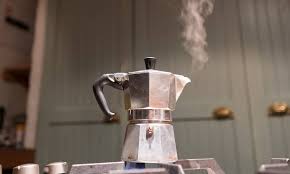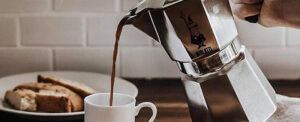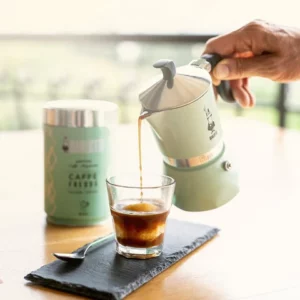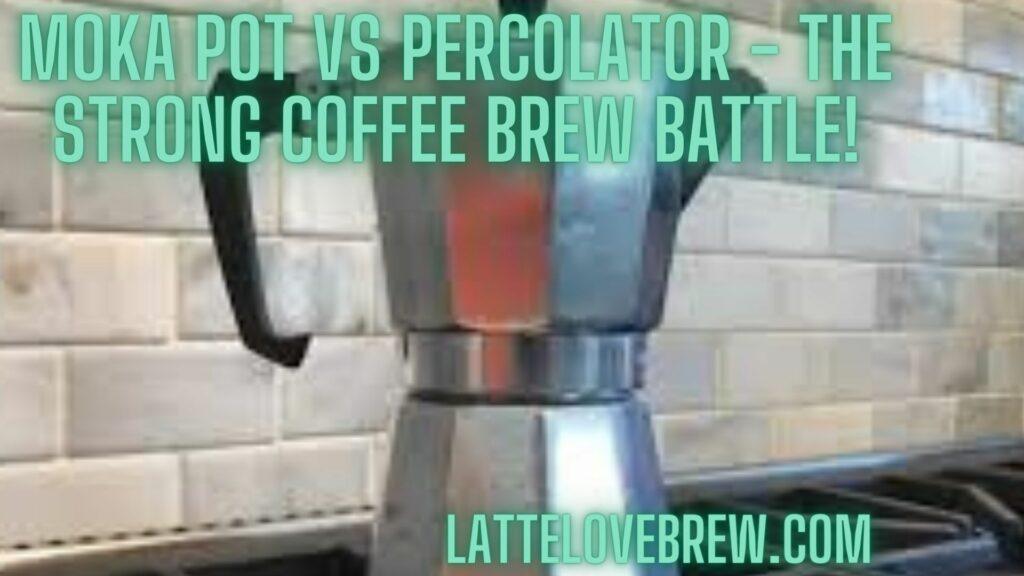Last updated on July 28th, 2024 at 14:36
In the great battle of the brew of the moka pot Vs percolator coffee you can only pick one…but which one?
Who is the winner of the epic battle of the brew?
Keep reading as we dig down and detail the different aspects of these two brewing methods and help you to decide which is better for you and meets your coffee needs.
Moka Pot Vs Percolator – The Brewing Process
Table Of Contents
- 1 Moka Pot Vs Percolator – The Brewing Process
- 2 Moka Pot Grind Size Vs Percolator Grind Size
- 3 Moka Pot Coffee To Water Ratio Vs Percolator Coffee To Water Ratio
- 4 Brewing Times For Moka Pot And Percolator Coffee
- 5 What Does The Final Cup Of Coffee Taste like?
- 6 Moka Pot Vs Percolator: Which One Should You Buy?
- 7 Frequently Asked Questions About Moka Pot Vs Percolator
- 7.1 Why Is Moka Pot Better?
- 7.2 What Is The Difference Between Espresso And Moka Pot?
- 7.3 Is A Moka Pot Healthy?
- 7.4 Does Moka Pot Make Better Coffee?
- 7.5 Why Is Moka Pot Coffee So Strong?
- 7.6 Is A Moka Pot Just A Percolator?
- 7.7 Can A Percolator Make Espresso?
- 7.8 Is It Safe To Drink Coffee From Moka Pot?
- 8 Frappé-Ing It All Up – Moka Pot Vs Percolator
A wise man once said that the daily coffee experience is not just about the coffee, it is about the whole experience and process of brewing the perfect cup of coffee. This is even more so with the meditation-like process of making a pour over coffee.
Let’s crack on and get talking about and comparing the brewing process of a coffee percolator and the stovetop espresso maker that is the moka pot.

Read: Types of coffee percolators
Moka Pots
A moka pot gives you the opportunity to brew quality rich and perfectly balanced shots of a focused coffee, while a percolator (more on these later), produces a strong bitter tasting coffee that lacks complexity in its flavor due to the rather elevated brewing temperature.
I love the moka pot due to the brewing process being very predictable and very straight forward. The device uses hot steam and steam pressure to brew a concentrated and rather strong form of coffee that is referred to as an espresso or a stovetop espresso, both of which are not at all accurate.
What you will get is a strong shot of coffee that resembles an espresso and is espresso-like. Experienced espresso drinkers and coffee lovers will notice the difference when drinking such a coffee.
Visually, it lacks the thick crema on top, and on the occasion that you can get crema it lacks consistency and does not stay for long at all. The slight creamy flavor when compared to a genuine espresso shot is missing.
To brew a top quality moka pot coffee you are best to fill the lower chamber with pre-heated water to 70C (158F). Add finely ground coffee to your filter basket and tamp gently, then add more grounds and tamp again. The tamping and adding extra coffee grounds is for making an extra strong coffee.
Then put the coffee basket in its place and re-assemble the coffee brewing device and place it on your stovetop. Let the water heat and produce the steam required. When it is ready, you will hear your brewer percolate.
Brewing time will take 3 to 5 minutes. The steam produces around 1.5 bars of pressure to water up through the bed of coffee and into the upper chamber. The pressure is nowhere near enough to produce a proper espresso, which needs 9 bar of pressure.
The advantages of the moka pot brewing process:
- Consistency: You can count on this technique to brew consistently good coffee.
- Simplicity: It is a very easy to learn process, There is nothing complicated at all.
There are some disadvantages, also, which are:
- The Learning Curve: It can take you a while to find the perfect point of extraction.
- Limitations Of The Device: How much coffee you brew is limited by the size of the coffee basket. You can use a larger device, fill it with coffee and use less water to get stronger coffee if you wish. You are also limited how many cups you can make.

Read: Small coffee percolator
Percolators
Stovetop and cheap electric versions overheat the water, effectively boiling your coffee.
It is easy to over extract your coffee if you are not paying attention to it.
A coffee percolator is considered as a set it and forget it brewing method. I disagree. Coffee brewers of this type must be monitored to ensure that you do not over-extract your coffee.
This (over-extraction) is something that can happen if you are using a stovetop percolator more than an electric percolator. Like the moka pot, which also has a modern electric version, a percolator can fall into the category of stovetop coffee brewers.
The process of percolation is one that uses a little pressure, which is caused by heat and the bubbles to force hot water up the central rod which acts as a straw. The almost boiling water rises up the rod or straw and is then distributed over a spreader plate and showered over a bed of coffee and then back down into the water chamber as coffee.
It continuously brews coffee by cycling the water and coffee mix until it is ready and fully brewed.
The method is as simple as the moka pot brewer above where you start by filling the chamber with water, add your ground coffee to the mesh filter basket and then place your percolator in contact with heat or switch it on if it is an electric percolator.
The main difference between a coffee percolator and a moka pot is that a percolator does not collect the brewed coffee in a separate chamber, it continues to brew the coffee. This is why you need to watch your brew to ensure that it does not overbrew your coffee.
Usually 5 to 8 minutes is long enough to brew a good strong coffee. The amount of time will vary depending on which device is used, coffee grounds and grind size.
The advantages of a coffee percolator are:
- Choose How Strong Your Coffee Is: You can get your coffee to be as strong as you want. When it hits the desired strength, just stop brewing.
- An Easy Brewing Method: Really, no brewing skills are needed. Just watch out for over brewing.
- Great For Making Batches Of Coffee: Got a lot of guests? A percolator will sort that problem out for you.
Not everything is plain sailing, there are some drawbacks which are:
- Stovetop and cheap electric versions overheat the water, effectively boiling your coffee.
- It is easy to over extract your coffee if you are not paying attention to it.
Moka Pot Grind Size Vs Percolator Grind Size
Let’s have a look at the different grind size for the two brewing techniques. Using the correct grind size is very important. Get it wrong and your coffee will taste off.
Moka Pot Grind Size
The ideal grind size for making moka pot coffee is a fine grind of around 200 to 250 microns. It is a typical espresso grind.
Percolator Grind Size
A percolator needs to have a coarse grind size. As coarse as your coffee grinder will permit, the reason for such a coarse grind size is the contact time of the water. If you use a smaller grind size your coffee will be over-extracted and bitter.
The physical size is 1 mm or 1/32.
Moka Pot Coffee To Water Ratio Vs Percolator Coffee To Water Ratio
Using the correct coffee to water ratio for your brewing method is as important as using the correct grind size.
Moka Pot Coffee To Water Ratio
For a good cup of moka pot coffee, a coffee to water ratio of 1:12 is good for brewing a good strong coffee. That is 15 grams of coffee and 180 grams of water. It is much better to weigh both your coffee and water with a coffee scale.
Percolator Coffee To Water Ratio
For a top quality percolated coffee, a good coffee to water ratio to start with is 1:15. This ratio will make a strongly caffeinated coffee. 12 grams of coffee and 180 grams of water. Again, as above, get into the habit of using a coffee scale to weigh your grounds.

Brewing Times For Moka Pot And Percolator Coffee
The brewing time is something that you need to keep a watchful eye on with your percolator coffee as it is a continuous cycle of brewing and may over brew if you are not careful. Typical brewing time is 5 to 8 minutes.
A moka pot will brew in 3 to 5 minutes typically. With a moka pot you will get notably better tasting coffee if you start with your water preheated to 70C (158F).
What Does The Final Cup Of Coffee Taste like?
All coffee enthusiasts know that the actual brewing process used can dramatically change how a coffee tastes when using the exact same coffee beans.
Percolator Coffee
Percolated coffee can be enjoyed either as a straight black coffee or with milk. You can control the strength of the brew. Generally speaking, a percolated coffee is slightly and noticeably bitter which is directly related to the high brewing temperature or is over concentrated from being over brewed.
It is a great tasting coffee when you can master the brewing method, which should only take a cup or two.
Moka Pot Coffee
This espresso-like coffee, with an emphasis on “espresso-like” as it is not quite an espresso, it is concentrated, rich and can be enjoyed straight or with steamed milk. You can make all the milk-based espresso drinks like a latte, cortado, flat white, mocha, cortado etc.
If it is too strong, you can even add a dash of hot water to dilute it.
Both these make very different coffee and taste very different. A moka pot can be considered as a low-cost alternative to an espresso, while the other is a double brewed coffee with a very strong caffeine kick.

Moka Pot Vs Percolator: Which One Should You Buy?
This choice is entirely up to you, and is one that only you can make. The influencing factors are what type of coffee you like and what type of coffee you want to make.
Where you make your coffee is not particularly a question as both a percolator and a moka pot can be enjoyed in the great outdoors. For camping trips, a percolator has the advantage of being able to make coffee for groups of people, a moka pot. Even though there are larger versions, it generally fails at this task.
If you want to make cappuccinos, flat whites, cortados, lattes, macchiatos and the whole range of milk based coffee drinks, then a moka pot is much better for you. While you can add milk to your percolator coffee, it is not concentrated enough to make milk-based espresso drinks.
If you want to make good use of your specialty coffee beans, a moka pot is much better at this as the coffee is balanced, rich and of sufficient concentration. Percolator coffee can be used for specialty coffee and make good quality coffee, but a moka pot does it much better.
My own personal preference between the two is for a moka pot.
Frequently Asked Questions About Moka Pot Vs Percolator
Why Is Moka Pot Better?
Moka pot coffee is better than a percolator and a drip coffee maker for making milk-based espresso drinks at home. The coffee produced is not quite a shot of espresso and best described as espresso-like. It’s not as strong as a proper shot of espresso.
A moka pot brews a rich and intense cup of coffee but is lacking to be called a true espresso. For a start it is lacking the required pressure to produce the rich thick crema on top.
What Is The Difference Between Espresso And Moka Pot?
A moka pot coffee can produce a good quality, rounded and balanced sweet coffee. It is as close to an espresso as you can get without using an espresso machine. The main difference is the lack of a good quality thick crema on top that is consistent and stays there.
Also, an espresso has more body than a moka pot coffee and is more intense.
Is A Moka Pot Healthy?
Some people worry about a moka pot being healthy or unhealthy. While it is not any more toxic than cooking with aluminum or stainless steel cooking pots. The quantity of the aluminum or stainless steel that makes its way into your coffee is incredibly small.
Copper moka pots are harder to find but technically would be the healthiest option.
Does Moka Pot Make Better Coffee?
It’s a very subjective question. What is certain is moka pot makes a very good, tasty cup of coffee, a very good coffee. I’ve been known to enjoy a good moka pot coffee. It is almost perfect for making milk-based espresso drinks at home or while out camping.
Why Is Moka Pot Coffee So Strong?
The reason moka pot is so strong is because of the pressurized brewing process. The water is heated in an almost sealed environment where steam and pressure are created. This pressure forces the water up through the finely ground coffee and into the coffee chamber.
Is A Moka Pot Just A Percolator?
No, a moka pots and a percolator are distinctly different. Percolators continually brew coffee where the hot water moves up and through the central tube and over the coffee grounds on a continual loop while moka pots brew only once. The hot water rises through the coffee grounds and then remains in the coffee chamber. Moka posts don’t continually brew coffee in an open loop like a percolator.
The two coffees produced by the different brewing methods taste different also.
Can A Percolator Make Espresso?
No, a percolator cannot make an espresso, it is not designed to and lacks the pressure to create the thick rich crema on an espresso. A percolator does make a strong coffee that is larger in volume and with a great level of intensity.
Is It Safe To Drink Coffee From Moka Pot?
Yes, it is perfectly safe to drink coffee from a moka pot, but you must clean it well to prevent the build up of coffee oils and tiny particles of coffee.
Frappé-Ing It All Up – Moka Pot Vs Percolator
I hope that you have found which of these two brewing techniques for you is most suitable in the battle of moka pot Vs percolator coffee. I am not one for telling which of the two to pick as your coffee likes and dislikes and needs are probably different from mine, which I totally respect.
I genuinely hope that you are much better informed and can make a better choice after having read this far.
Join our fun and friendly coffee community where we talk about all things related to coffee from beans and brewing methods to great recipes and more.







